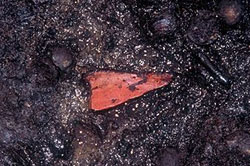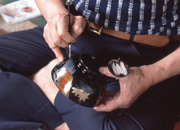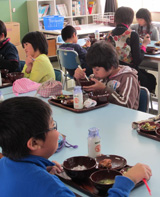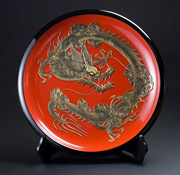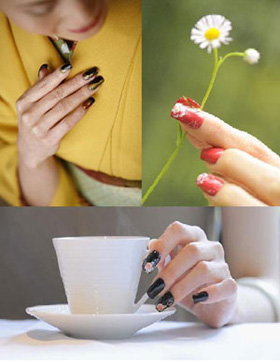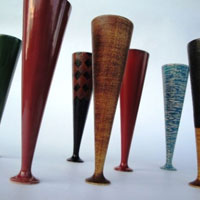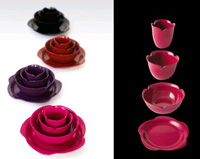Web Japan > Trends in Japan > Fashion&Design > Shikki (lacquerware) Masterpiece of
Japanese Traditional Art
Shikki (lacquerware)
Masterpiece of Japanese Traditional Art

A Wajima lacquerware writing utensil case decorated with autumn grasses, elegantly drawn using the makie technique. © Wajima Lacquerware Commerce and Industrial Cooperative Union
Enlarge photo“What is Japan’s representative traditional art and craft?” To this question, many Japanese would answer, “Shikki (lacquerware).” Lacquerware is wooden containers and utensils made by applying many coatings of resin, harvested from trees such as poison oaks or black trees. The items are then decorated using various techniques. Lacquerware has a subdued luster and is smooth to the touch. It exudes a sense of warmth only wood can give, and the colors are deep and fascinating. Lacquerware has thousands of years of history, with the first pieces reaching Europe around the 16th century. By the 18th century, Marie Antoinette, Queen of France, had a large collection of lacquerware. The beauty of lacquerware, in which Japan takes pride, continues to charm people around the world. While porcelain is called “china,” lacquerware is truly “japan.”
Art objects from 5,500 years ago
The Japanese have been making lacquerware since the Jomon period some 12,000-2,500 years ago. And despite their great antiquity, the brightness of colors of lacquerware from the Jomon period is stunning even today. At the Sannai Maruyama Site in Aomori City, Aomori Prefecture, on the northern tip of Honshu, Japan’s largest and most heavily populated island, pieces of lacquered wooden plates have been unearthed that are estimated to be 5,500 years old. Remarkably, these pieces still retain a bright vermilion coating. And when the fragments are put back together, the restored pieces show the amazingly high technological level of the times, rivaling even that of today.
In fact, contemporary Japanese lacquerware is made using technology and techniques passed down from ancient time — solid black or vermilion lacquerware, pieces with exquisitely rendered decoration, etc. Techniques used today to produce the most gorgeous Japanese lacquerware have evolved over centuries of craftsmanship.
The most well-known technique is makie (gold or silver-sprinkled lacquerware), which is made by using a brush to draw designs with lacquer resin, then sprinkling gold or silver powder on the wet design and polishing it over and over. There is also chinkin (lacquer with gold inlay), made by carving designs on a lacquered surface and then rubbing gold or silver leaf into the fine lines. Raden (mother-of-pearl) lacquerware is made using thinly shaved leaves from glittering seashells, such as abalone, set on a lacquered surface. All of these techniques originated from the delicacy and precision of the Japanese people. Lacquer art objects have been admired abroad since the 16th century as they display these attributes and sensibilities of the Japanese people.
Fascinating beauty
Wajima City in Ishikawa Prefecture, on the Noto Peninsula which juts out into the Sea of Japan from the west coast of Honshu, is where Wajima-nuri, or Wajima lacquerware, is produced. Wajima lacquerware has a history of some 500 years, and is known both for its elegance and sturdiness. The pieces are coated with lacquer and polished, and as these processes are repeated over and over, it takes more than 100 steps to make Wajima lacquerware. Wajima lacquerware, which uses a lot of gold on a black, lacquered surface, is visually stunning and magnificent. Many pieces are viewed as true art objects, though conceived of as items for practical use.
For many centuries, the Japanese have been using beautifully designed, exquisitely made lacquerware in their daily lives. A good example is Kawatsura shikki (Kawatsura lacquerware), produced in Yuzawa City, Akita Prefecture, on the Sea of Japan coast in the Tohoku (northeastern) region. Kawatsura lacquerware, with 800 years of history, does not have eye-catching decorations. But it is so sturdy and practical that it is said, “Once you buy it, it will last through your grandchildren’s generation.” Lacquerware can be re-coated and used for decades. It is made of natural materials and so free of man-made chemicals, reflecting the history of the Japanese people, who have always lived with a reverence toward nature and in harmonious coexistence. To pass on to children an appreciation of these attributes of this local lacquerware, some elementary schools use Kawatsura lacquerware for school lunches.
Ryukyu shikki (Ryukyu lacquerware), produced in Okinawa Prefecture, Japan's southwesternmost island group, is bright vermilion in color as it is exposed to abundant ultraviolet rays. The unique designs also show the influence of many centuries of trade between Okinawa and other regions of East Asia. While most Japanese lacquerware features drawings of plants, Ryukyu shikki features flying dragons and other exotic designs. Tsuikin technique, which is said to have originated in Ryukyu (an ancient name for Okinawa) in the 18th century, features dynamic expressions due to its three-dimensional relief.
Rings and nail tips
While Japanese lacquerware has a long history, many objects have been developed in recent years to be enjoyed as home-interior decorations or as fashion items, attracting the attention of young women in particular. This is an expression of another Japanese national characteristic — that of making improvements again and again on existing items.
An example is Hidehira-nuri (Hidehira lacquerware), made in Hiraizumi Town in Iwate Prefecture in the Tohoku region, where the Chuson-ji Buddhist Temple and other historical buildings and gardens were designated in June 2011 as a World Cultural Heritage site by UNESCO. It has introduced new concepts, such as wooden shot glasses and brandy glasses for toasting. The unique, cone-shaped shot glasses are modeled after party crackers. Their shape and colors render them suitable also as interior decoration items. Toasting with these glasses makes a sip of anything even more delectable.
Kagawa shikki (Kagawa lacquerware), produced in Kagawa Prefecture in Shikoku, the fourth largest island in the Japanese archipelago, now includes sets of a tea cup, a rice or soup bowl, a large bowl and a plate, which, when put together, look like rose blossoms. This beautiful serving ware also adds rich color to your table.
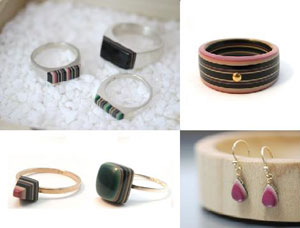
Rings and earrings made by applying many layers of lacquer, producing deep, subdued colors. © MIYABICA URUSHI JEWELRY
Enlarge photoThe application of lacquer, utilizing Japanese traditional colors and design sense, also is being used now “to do” women’s fingernails — with stunning effect. Rings and pierce-type earrings in eye-catching colors, made by applying many layers of lacquer, have become popular fashion accessories as well. The deep, subdued colors unique to lacquer are very popular among women.
Lacquer, with its deep roots in the lives of the Japanese people, truly captures Japan’s traditional notions of beauty, backed by thousands of years of history. Yet while preserving the tradition, the Japanese have introduced many new ways of enjoying lacquerware. They are art objects created by the Japanese and admired around the world. (July 2012)
- New Trend in Hairstyles (March 2012)


